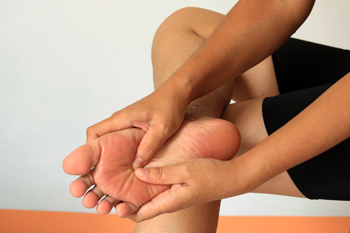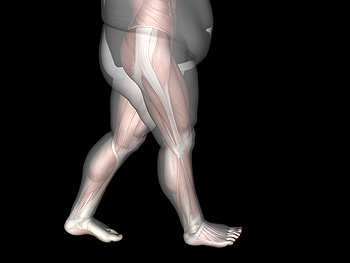Items filtered by date: June 2020
Diagnosing Heel Spurs
 Heel spurs are bone growths that form on the bottom of the foot that can cause heel pain. Heel spurs can also occur with conditions such as plantar fasciitis or Achilles tendonitis. They can be caused by both muscle and ligament strains in the foot, particularly when the tissue connecting the heel to the ball of the foot gets overstretched. If you are experiencing heel pain and possibly heel spurs, it is important to consult with a podiatrist. A podiatrist will be able to properly diagnose heel spurs by having an X-ray taken, and provide treatment solutions such as stretching exercises or physical therapy.
Heel spurs are bone growths that form on the bottom of the foot that can cause heel pain. Heel spurs can also occur with conditions such as plantar fasciitis or Achilles tendonitis. They can be caused by both muscle and ligament strains in the foot, particularly when the tissue connecting the heel to the ball of the foot gets overstretched. If you are experiencing heel pain and possibly heel spurs, it is important to consult with a podiatrist. A podiatrist will be able to properly diagnose heel spurs by having an X-ray taken, and provide treatment solutions such as stretching exercises or physical therapy.
Heel spurs can be incredibly painful and sometimes may make you unable to participate in physical activities. To get medical care for your heel spurs, contact Dr. John P. Beaupied from Palos Podiatry. Our doctor will do everything possible to treat your condition.
Heels Spurs
Heel spurs are formed by calcium deposits on the back of the foot where the heel is. This can also be caused by small fragments of bone breaking off one section of the foot, attaching onto the back of the foot. Heel spurs can also be bone growth on the back of the foot and may grow in the direction of the arch of the foot.
Older individuals usually suffer from heel spurs and pain sometimes intensifies with age. One of the main condition's spurs are related to is plantar fasciitis.
Pain
The pain associated with spurs is often because of weight placed on the feet. When someone is walking, their entire weight is concentrated on the feet. Bone spurs then have the tendency to affect other bones and tissues around the foot. As the pain continues, the feet will become tender and sensitive over time.
Treatments
There are many ways to treat heel spurs. If one is suffering from heel spurs in conjunction with pain, there are several methods for healing. Medication, surgery, and herbal care are some options.
If you have any questions feel free to contact our office located in Palos Heights, IL . We offer the latest in diagnostic and treatment technology to meet your needs.
How Can I Protect My Feet While Running?
 Running is a very popular activity. However, one can seriously damage the feet if they do not practice following simple safety procedures. For runners who are just beginning, it is important to start slow and steady, being sure not to strain the ligaments of the lower extremities. Overuse is a common reason why many runners end up damaging their feet and developing conditions such as Achilles tendonitis. The body needs time to adapt to this new physical activity, which is why stretching before and after each run can help prepare the legs and feet, as well as cool them down after a run is completed. Plantar fasciitis is another foot condition that is common among runners, specifically affecting the heel region. To help prevent injury, it is also important to ensure you’re choosing the proper shoe for your style of running, and that you’re getting the support necessary for your level of activity. For more information on how to avoid obtaining a running injury, it is suggested that you consult with a podiatrist for professional advice.
Running is a very popular activity. However, one can seriously damage the feet if they do not practice following simple safety procedures. For runners who are just beginning, it is important to start slow and steady, being sure not to strain the ligaments of the lower extremities. Overuse is a common reason why many runners end up damaging their feet and developing conditions such as Achilles tendonitis. The body needs time to adapt to this new physical activity, which is why stretching before and after each run can help prepare the legs and feet, as well as cool them down after a run is completed. Plantar fasciitis is another foot condition that is common among runners, specifically affecting the heel region. To help prevent injury, it is also important to ensure you’re choosing the proper shoe for your style of running, and that you’re getting the support necessary for your level of activity. For more information on how to avoid obtaining a running injury, it is suggested that you consult with a podiatrist for professional advice.
All runners should take extra precaution when trying to avoid injury. If you have any concerns about your feet, contact Dr. John P. Beaupied of Palos Podiatry. Our doctor will treat your foot and ankle needs.
How to Prevent Running Injuries
There are a lot of mistakes a runner can make prior to a workout that can induce injury. A lot of athletes tend to overstretch before running, instead of saving those workouts for a post-run routine. Deep lunges and hand-to-toe hamstring pulls should be performed after a workout instead of during a warmup. Another common mistake is jumping into an intense routine before your body is physically prepared for it. You should try to ease your way into long-distance running instead of forcing yourself to rush into it.
More Tips for Preventing Injury
- Incorporate Strength Training into Workouts - This will help improve the body’s overall athleticism
- Improve and Maintain Your Flexibility – Stretching everyday will help improve overall performance
- “Warm Up” Before Running and “Cool Down” Afterward – A warm up of 5-10 minutes helps get rid of lactic acid in the muscles and prevents delayed muscle soreness
- Cross-Training is Crucial
- Wear Proper Running Shoes
- Have a Formal Gait Analysis – Poor biomechanics can easily cause injury
If you have any questions, please feel free to contact our office located in Palos Heights, IL . We offer the newest diagnostic and treatment technologies for all your foot care needs.
Are Bunions Affecting Your Everyday Life?
Why Do I Feel Pain in The Ball of My Foot?
 Morton’s neuroma is a condition that affects the nerves of the foot, often causing pain in the ball of foot. This condition can develop due to increased pressure, injury, or from ill-fitting footwear such as high heels. Patients affected with this condition often describe the feeling as if there is a pebble stuck inside of their shoe. Morton’s neuroma may cause a stinging, burning, or numbing sensation in the ball of the foot or toes. Some patients have found relief by wearing custom orthotics, shoe inserts, and by performing certain foot exercises. For a proper diagnosis and advised treatment plan, it is suggested that you consult with a podiatrist.
Morton’s neuroma is a condition that affects the nerves of the foot, often causing pain in the ball of foot. This condition can develop due to increased pressure, injury, or from ill-fitting footwear such as high heels. Patients affected with this condition often describe the feeling as if there is a pebble stuck inside of their shoe. Morton’s neuroma may cause a stinging, burning, or numbing sensation in the ball of the foot or toes. Some patients have found relief by wearing custom orthotics, shoe inserts, and by performing certain foot exercises. For a proper diagnosis and advised treatment plan, it is suggested that you consult with a podiatrist.
Morton’s neuroma is a very uncomfortable condition to live with. If you think you have Morton’s neuroma, contact Dr. John P. Beaupied of Palos Podiatry. Our doctor will attend to all of your foot care needs and answer any of your related questions.
Morton’s Neuroma
Morton's neuroma is a painful foot condition that commonly affects the areas between the second and third or third and fourth toe, although other areas of the foot are also susceptible. Morton’s neuroma is caused by an inflamed nerve in the foot that is being squeezed and aggravated by surrounding bones.
What Increases the Chances of Having Morton’s Neuroma?
- Ill-fitting high heels or shoes that add pressure to the toe or foot
- Jogging, running or any sport that involves constant impact to the foot
- Flat feet, bunions, and any other foot deformities
Morton’s neuroma is a very treatable condition. Orthotics and shoe inserts can often be used to alleviate the pain on the forefront of the feet. In more severe cases, corticosteroids can also be prescribed. In order to figure out the best treatment for your neuroma, it’s recommended to seek the care of a podiatrist who can diagnose your condition and provide different treatment options.
If you have any questions, please feel free to contact our office located in Palos Heights, IL . We offer the newest diagnostic and treatment technologies for all your foot care needs.
Heel Pain May Be Present In Overweight People
 Research has indicated heel pain may be experienced by people who are overweight. This can be a result of the added weight the feet carry as daily activities are performed. Significant heel pain can be indicative of plantar fasciitis, and this occurs when the plantar fascia becomes inflamed. Patients who are overweight can notice symptoms of this condition, and it often begins with heel pain. The feet may feel better when excess weight is reduced, and this can be accomplished by consuming fewer calories. Additionally, it is beneficial to engage in a daily exercise routine, despite the discomfort the feet may feel. If you would like more information about how the feet are affected by obesity, please consult with a podiatrist.
Research has indicated heel pain may be experienced by people who are overweight. This can be a result of the added weight the feet carry as daily activities are performed. Significant heel pain can be indicative of plantar fasciitis, and this occurs when the plantar fascia becomes inflamed. Patients who are overweight can notice symptoms of this condition, and it often begins with heel pain. The feet may feel better when excess weight is reduced, and this can be accomplished by consuming fewer calories. Additionally, it is beneficial to engage in a daily exercise routine, despite the discomfort the feet may feel. If you would like more information about how the feet are affected by obesity, please consult with a podiatrist.
Obesity has become very problematic at this point in time and can have extremely negative effects on the feet. If you’re an obese individual and are concerned about your feet, contact Dr. John P. Beaupied from Palos Podiatry. Our doctor can provide the care you need to keep you pain-free and on your feet.
Obesity and Your Feet
Since your feet are what support your entire weight when standing, any additional weight can result in pain and swelling. Being overweight is one of the main contributors to foot complications.
Problems & Complications
Extra Weight – Even putting on just a few extra pounds could create serious complications for your feet. As your weight increases, your balance and body will shift, creating new stresses on your feet. This uneven weight distribution can cause pain, even while doing the simplest tasks, such as walking.
Diabetes – People who are overweight are at serious risk of developing type-2 diabetes, which has a drastic impact on the health of your feet. As you get older, your diabetes might worsen, which could lead to loss of feeling in your feet, sores, and bruises. You could also become more prone to various infections.
Plantar fasciitis – Pressure and stress that is placed on muscles, joints, and tendons can trigger plantar fasciitis, which is an inflammation of tissue that forms along the bottom of the foot.
If you have any questions please feel free to contact our office located in Palos Heights, IL . We offer the newest diagnostic and treatment technologies for all your foot and ankle needs.
Sever’s Disease Symptoms
 When the tendons around the heel’s growth plate become inflamed, it is likely that Sever’s disease may develop. This condition is often common among growing teens who participate in sporting activities. Sever’s disease can be caused by repetitive stress to the heel. It can also develop when other structures of the body, such as bones, tendons, and muscles grow at different rates. Common symptoms include heel pain, redness, and swelling of the affected area. This condition may also make it uncomfortable or painful to walk and run, and can cause tenderness to the heel. For more information on how Sever’s disease can be treated, it’s suggested you consult with a podiatrist.
When the tendons around the heel’s growth plate become inflamed, it is likely that Sever’s disease may develop. This condition is often common among growing teens who participate in sporting activities. Sever’s disease can be caused by repetitive stress to the heel. It can also develop when other structures of the body, such as bones, tendons, and muscles grow at different rates. Common symptoms include heel pain, redness, and swelling of the affected area. This condition may also make it uncomfortable or painful to walk and run, and can cause tenderness to the heel. For more information on how Sever’s disease can be treated, it’s suggested you consult with a podiatrist.
Sever's disease often occurs in children and teens. If your child is experiencing foot or ankle pain, see Dr. John P. Beaupied from Palos Podiatry. Our doctor can treat your child’s foot and ankle needs.
Sever’s Disease
Sever’s disease is also known as calcaneal apophysitis, which is a medical condition that causes heel pain I none or both feet. The disease is known to affect children between the ages of 8 and 14.
Sever’s disease occurs when part of the child’s heel known as the growth plate (calcaneal epiphysis) is attached to the Achilles tendon. This area can suffer injury when the muscles and tendons of the growing foot do not keep pace with bone growth. Therefore, the constant pain which one experiences at the back of the heel will make the child unable to put any weight on the heel. The child is then forced to walk on their toes.
Symptoms
Acute pain – Pain associated with Sever’s disease is usually felt in the heel when the child engages in physical activity such as walking, jumping and or running.
Highly active – Children who are very active are among the most susceptible in experiencing Sever’s disease, because of the stress and tension placed on their feet.
If you have any questions, please feel free to contact our office located in Palos Heights, IL . We offer the newest diagnostic and treatment technologies for all your foot and ankle injuries.




